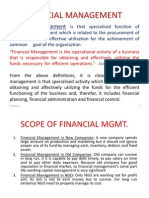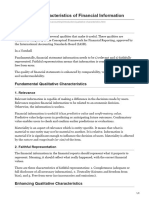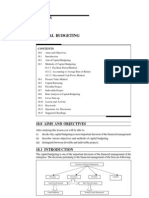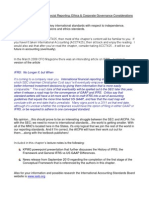Resource Allocation
Uploaded by
aditiResource Allocation
Uploaded by
aditiUnit 10: Strategy Implementation
10.5 Resource Allocation Notes
Most strategies need resources to be allocated to them if they are to be implemented successfully.
Let us examine some special circumstances that may affect the allocation of resources.
Resource allocation deals with the procurement and commitment of financial, physical and
human resources to strategic tasks for achievement of organisational objectives. This involves
the process of providing resources to particular business units, divisions, functions etc for the
purpose of implementing strategies. All organisations have at least five types of resources:
1. Physical Resources
2. Financial Resources
3. Human Resources
4. Technological Resources
5. Intellectual Resources
These resources may already exist in the organisation or may have to be acquired. Resource
allocation decisions are very critical in that they set the operative strategy for the firm. Resource
allocation decisions about how much to invest in which areas of business reinforce the strategy
and commit the organisation to the chosen strategy.
10.5.1 Importance of Resource Allocation
A company’s ability to acquire sufficient resources needed to support new strategic initiatives
and steer them to the appropriate organisational units has a major impact on the strategy
implementation process. Too little funding arising from constrained financial resources or from
sluggish management action slows progress and impedes the efforts of organisational units to
execute their part of the strategic plan effectively.
At the same time, too much funding wastes organisational resources and reduces financial
performance. Both these extremes emphasize the need for managers to be careful about resource
allocation. Resource allocation becomes a critically important exercise when there are major
shifts from the past strategies in terms of product/market scope. For example, if the firm’s
strategy is expansion in one line, withdrawal from another and stability in the rest of the
products, then greater resources will have to flow to the first and lesser to the second and the
third. Similarly, if the strategy is to develop competitive edge through product development,
greater resources will have to be committed to R&D.
Resource allocation is a powerful means of communicating the strategy in the organisation as it
gives the signals to all concerned. It will demonstrate what strategy is really in operation.
Resource allocation decisions should be taken judiciously because using a formula approach
(i.e. allocating funds as a percentage of sales or profits), may be inappropriate and counter-
productive. Care should be taken to see that the resources are not allocated or withdrawn
because of easy availability or paucity.
Example: Cutting down R&D budget in view of sudden fall of profitability should be
avoided as such expenditure may be most critical for developing future competitive advantage.
The resource allocation decisions are generally linked to the objectives. For example, decision
about dividend payment is linked to the ability of the company to attract capital. How to
distribute the expected profits among investors, employees and the company’s own needs is an
important resource allocation decision from the viewpoint of long-term implications of the
strategy.
LOVELY PROFESSIONAL UNIVERSITY 191
Strategic Management
Notes
Notes Broadly, there are three approaches to resource allocation:
1. Top-down approach
2. Bottom-up approach
3. Strategic budgeting
1. Top-Down approach: In this approach, resources are allocated through a process of
segregation down to the operating levels. The Board of Directors, the Managing
Director or members of top management typically decide the requirements of each
subunit and distribute resources accordingly.
2. Bottom-up approach: In this approach, resources are distributed through a process
of aggregation from the operating level. The operating levels work out the
requirements of each subunit and the resources are allocated accordingly.
3. Strategic budgeting: This approach is a mix of the above two approaches, and involves
an interactive form of decision-making between different levels of management.
10.5.2 Managing Resource Conflict
The common approach to resource allocation is through budgetary system. There are however,
many other tools, which can be used for this purpose. Some of the important tools used for
resource allocation are discussed below:
BCG Matrix
The BCG matrix, which is generally used for portfolio analysis, can also be used as a guideline
for resource allocation. The surplus resources from “cash cows” can be reallocated to “stars” or
“question marks”. In so far as businesses categorized as “dogs” are concerned, with low growth
and low market share, they may not need any thrust, and resources can be gradually withdrawn
from such businesses and invested in other promising businesses.
The BCG matrix is a useful tool because it impresses upon a portfolio approach to resource
allocation. It helps in averting over-investment in any particular type of business and under-
investment in promising businesses from the long-term perspective. Despite the utility of the
BCG matrix, however, it should be used with care and only as a guideline. It does not provide a
concrete measure for making a finer choice, particularly among the businesses of the same
nature.
PLC-based Budgeting
Resource allocation can also be linked to different stages of a Product Life Cycle (PLC). A
product in introductory and growth stages may require more resources than a product in mature
and decline stages.
Zero-based Budgeting (ZBB)
The key differences between ZBB and traditional budgeting is that ZBB requires managers to
justify their budget requests in detail from the scratch, without relying on the previous budget
allocations. Therefore, instead of taking the last year’s budget as the base for projecting the
future allocations, ZBB forces the managers to review the objectives and operations afresh and
192 LOVELY PROFESSIONAL UNIVERSITY
Unit 10: Strategy Implementation
justify the budget requests. ZBB is, therefore, a type of budget that requires managers to rejustify Notes
the past objectives, projects and budgets and set priorities for the future. It amounts to recalculation
of all organisational activities to see which should be eliminated or funded at a reduced or
increased level.
Capital Budgeting
Capital Budgeting techniques can be used for long-term commitment of resources, such as
capital investments in mergers, acquisitions, joint ventures, and setting up of new plants etc.
Various techniques like payback period, net present value, internal rate of return, etc. can be
used to find which investments would earn maximum returns.
Operating Budgets
Operating budgets are necessary for more routine resource allocation for conducting operations.
There are two types of systems:
1. Fixed budgeting system: This system commits resources based on activity levels. In this
type of budgeting, there may be a tendency to retain the committed resources even if the
activity levels are not being achieved, thus depriving other divisions of the resources,
which have a better potential.
2. Flexible budgeting system: This system provides for transfer of funds from one unit to
another if a fall is expected in actual activity level in a particular unit, thus ensuring better
resource utilization. But this system has the disadvantage of encouraging non-seriousness
about budgetary allocations.
Did u know? What are the different types of routine budgets?
1. Operating budget specifies materials, labour, overheads and other costs.
2. Financial budget projects cash receipts and disbursements.
3. Sales budget specifies sales revenues and selling, distribution and marketing costs.
4. Expenses budget projects expenses not carried out in other budgets.
10.5.3 Criteria for Resource Allocation Process
In large, diversified companies, the corporate office plays a major role in allocating resources
among various strategies proposed by its operating units or divisions. In many cases, product
groups, business units or functional areas may bid for funds to support their strategic proposals.
There are three criteria which can be used when allocating resources.
1. Contribution towards fulfillment of organisational objectives: At the centre of the
organisation, the resource allocation task is to steer resources away from areas that are
poor at delivering the organisation’s objectives and towards those that are good at
delivering the organisation’s objectives.
2. Support of key strategies: In many cases, the problem with resource allocation is that the
requests for funds usually exceed the funds normally available. Thus, there needs to be
LOVELY PROFESSIONAL UNIVERSITY 193
Strategic Management
Notes some further selection mechanism beyond the delivery of the organisation’s mission and
objectives. This second criterion relates to two aspects of resource analysis:
(a) Support of core competencies: Resources should develop and enhance core competencies
which, in turn, help achieve competitive advantage.
(b) Enhancement of value chain activities: Resources should assist particularly those
activities of the value chain which help the organisation to achieve low cost or
differentiation and thereby enhance and sustain competitive advantage of the firm.
(c) Risk-acceptance level of the organisation: Clearly, if the risk is higher, there is a lower
likelihood that the strategy will be successful. Some organisations will be more
comfortable with accepting higher levels of risk than others. So, the criterion in this
case needs to be considered in relation to the risk-acceptance level of the organisation.
!
Caution Sometimes, special circumstances may cause an organisation to amend the criteria
for allocation of resources, Those considerations are:
1. When major strategic changes are unlikely: In this situation, resources may be
allocated on the basis of a formula, e.g. marketing funds might be allocated as a
percentage of sales based on past history and experience. The major difficulty with
such an approach is its arbitrary nature. It may, however, be a useful shortcut.
2. When major strategic changes are predicted: In this situation, additional resources
may be required to respond to an expected competitive initiative. In this case, special
negotiation with the corporate office is required for resourcing rather than the
adherence to dogmatic criteria.
3. When resources are shared between divisions: In this situation, the corporate office
may seek to enhance its role beyond that of resource allocator. It may need to
establish the degree of collaboration and, where the areas disagree, impose a solution.
10.5.4 Factors affecting Resource Allocation
Resource allocation may not necessarily be a purely ‘rational’ decision-making process. It is also
a behavioural and political process involving people who may be motivated by different
objectives. Some of the major factors affecting resource allocation are discussed below:
1. Objectives of the organisation: People motivated by different objectives exercise their
influence over the funding of projects. There are two types of objectives. Official (explicit)
objectives and operative (implicit) objectives. Allocations of resources are more guided
by implicit objectives than explicit objectives. The formal and informal organisations also
influence the perception of which projects should be chosen for funding.
2. Powerful units: Sometimes, powerful SBU heads secure larger allocation of funds than
their ‘fair share’.
3. Dominant strategists: The preferences of dominant strategists like the CEO, Directors,
SBU heads, etc. are reflected in the way resources are allocated. The divisional and
departmental heads know that such preferences matter and try to present their demands
in line with them.
4. Internal politics: Resources are often construed as power, and those units, which manage
to secure substantial resources, are perceived as more powerful than others. Internal
politics within the organisation to secure more and more resources, affect the process of
resource allocation.
194 LOVELY PROFESSIONAL UNIVERSITY
Unit 10: Strategy Implementation
5. External influences: Apart from internal politics, external influences like government Notes
policy, demands of shareholders, financial institutions, community and others, also affect
resource allocation. For example, legal requirements may require additional finances in
labour welfare and social security, pollution control, safety equipments and energy
conservation. The shareholders may expect higher dividends, and resources have to be
directed to them. Financial institutions may impose restrictions or require companies to
invest in technology up-gradation and R&D. Similarly, the discharge of social
responsibilities by the firm requires allocation of sufficient funds. Thus, external influences
affect the process of resource allocation.
To sum up, we can say that the ‘behavioural’ and ‘political’ considerations are inevitable in a
typical organisation, but one must ensure that they do not dominate the ‘rational’ considerations
in allocation of resources. Otherwise, irrational allocation of funds may jeopardize effective
implementation of the strategy and lead to problems in achieving the desired strategic change.
Task Find out how Microsoft allocates its human and financial resources into various
units.
10.5.5 Difficulties in Resource Allocation
The resource allocation process can sometimes become fairly complex, and may even create
several difficulties to the strategists. Some of the difficulties that can create problems are:
1. Scarcity of Resources: Resources are hard to find. Even if finance is available, the cost of
capital could be a constraint. Non-availability of highly skilled people could be another
problem.
2. Restrictions on Generating Resources: Within organisations, the new units which have
greater potential for growth in the future, may not be able to generate resources in the
short run. Allocation of resources on par with existing SBUs, divisions and departments
through the usual budgeting process, will put them at a disadvantage.
3. Bloated Demands: Unit managers may sometimes submit inflated or overstated demands
for funds to guard against any budget-cuts. This subverts the decision process.
4. Negative Attitude: Units, which do not get the desired allocations, may develop a negative
attitude towards the corporate managers. They may work at cross purposes, which may
obstruct the implementation of the intended strategy.
5. Budget Battles: The actual allocation of funds to any unit has a major effect on the work
environment of the unit and the career of the manager concerned. If a manager loses the
‘budget battle’, his subordinates feel that the manager has failed them, and may not
cooperate with him.
6. Budgetary Process: The budgetary process itself can lead to problems if it is not tied to the
strategic plans of the firm. If top management fails to communicate the shifts in the
strategic plans and the lower levels are unaware of the shifts, any intended strategy is
unlikely to succeed .
7. New SBUs: The budgetary process is tied to the way units and divisions are arranged
organisationally. New SBUs can be at a disadvantage if they are unaware of the intricacies
of the budget procedures used in their organisations.
To avoid the above difficulties, strategists should pay maximum attention to resource allocation,
and ‘prioritize’ budgeting allocations in the initial stages taking overall objectives into account.
LOVELY PROFESSIONAL UNIVERSITY 195
Strategic Management
Notes Many ‘budget battles’ can be avoided if targets, resource sharing, prioritization, midway revisions
etc. are decided in an atmosphere of cooperation and participation, especially at departmental
and divisional levels.
Allocating resources to specific divisions and departments alone does not mean successful
implementation of the strategy. If major strategic shifts are occurring, the organisation structure
is likely to change along with the way resources are allocated.
Caselet No Fair!
T
he regular announcements in the Budget for women include the strengthening of
the Rashtriya Mahila Kosh for providing micro-credit to poor assetless women, the
launching of an integrated scheme for women's empowerment and the starting of
a new scheme for women in difficult circumstances such as the widows of Vrindavan,
Kashi and others who are destitute or disadvantaged.
However, the actual announcements in the Budget that impact women are more than
those announced under the specific women's bracket. Some are positive and some negative.
Resources are not fairly allocated for them.
Source: blonnet.com
10.6 Summary
Most strategies need resources to be allocated to them if they are to be implemented
successfully.
A successful strategy formulation does not guarantee successful strategy implementation.
It affects an organisation from top to bottom; it affects all divisional and functional areas
of business.
Implementation of strategy involves a number of interrelated decisions, choices, and a
broad range of activities. It requires an integration of people, structures, processes etc.
Mc Kinsey’s 7-S model is good at capturing the importance of all these elements in the
implementation of strategy.
A company’s ability to acquire sufficient resources needed to support new strategic
initiatives and steer them to the appropriate organisational units has a major impact on
the strategy implementation process.
10.7 Keywords
Bottom-up Approach: In this approach, resources are distributed through a process of aggregation
from the operating level. The operating levels work out the requirements of each subunit and
the resources are allocated accordingly.
Capital Budgeting: used for long-term commitment of resources, such as capital investments in
mergers, acquisitions, joint ventures etc.
McKinsey 7-S Model: A model of organisational effectiveness that postulates that there are
seven internal factors of an organisation that needs to be aligned and reinforced in order for it
to be successful.
196 LOVELY PROFESSIONAL UNIVERSITY
You might also like
- SFBC 2005-Conditions of Building Contract (W Q)100% (1)SFBC 2005-Conditions of Building Contract (W Q)114 pages
- Interview Questions As An Administrative OfficerNo ratings yetInterview Questions As An Administrative Officer2 pages
- Accounting and Financial Analysis Lecture Notes Lectures 1 10 PDF100% (1)Accounting and Financial Analysis Lecture Notes Lectures 1 10 PDF57 pages
- Standard Costing With Solutions: SolutionNo ratings yetStandard Costing With Solutions: Solution3 pages
- The Mechanics of Double-Entry Accounting: Slide 4.1100% (3)The Mechanics of Double-Entry Accounting: Slide 4.123 pages
- Cash Flow Statement: Projected Income Statement and Balance SheetNo ratings yetCash Flow Statement: Projected Income Statement and Balance Sheet14 pages
- CHAPTER 1 - Introduction of Finance & Financial ManagementNo ratings yetCHAPTER 1 - Introduction of Finance & Financial Management20 pages
- Mwunda, Nicholus M. - A Framework For Integration of ICTs in Teaching and Learning Processes in Secondary Schools in Machakos Sub-County100% (1)Mwunda, Nicholus M. - A Framework For Integration of ICTs in Teaching and Learning Processes in Secondary Schools in Machakos Sub-County70 pages
- Chapter 7 - Budgeting - Estimating Cost and RisksNo ratings yetChapter 7 - Budgeting - Estimating Cost and Risks8 pages
- Supplementing The Chosen Competitive Strategy: Other Important Strategy ChoicesNo ratings yetSupplementing The Chosen Competitive Strategy: Other Important Strategy Choices43 pages
- Accounting Theory Eldon Hendriksen PDF FreeNo ratings yetAccounting Theory Eldon Hendriksen PDF Free872 pages
- Key Terms of Activity-Based Costing (ABC) : Process Activities Include Machine Products and Assembled ProductsNo ratings yetKey Terms of Activity-Based Costing (ABC) : Process Activities Include Machine Products and Assembled Products4 pages
- Module I Overview of Working Capital TheoryNo ratings yetModule I Overview of Working Capital Theory15 pages
- Module 1 - Introduction To Management AccountingNo ratings yetModule 1 - Introduction To Management Accounting7 pages
- Project Management-An Integrated ApproachNo ratings yetProject Management-An Integrated Approach3 pages
- Strategic Profitability Analysis (CH 12)No ratings yetStrategic Profitability Analysis (CH 12)48 pages
- Qualitative Characteristics of Financial InformationNo ratings yetQualitative Characteristics of Financial Information2 pages
- Chapter-9: Accounting For Receivable: Types of ReceivablesNo ratings yetChapter-9: Accounting For Receivable: Types of Receivables24 pages
- The Goals and Functions of Financial Management: Powerpoint Presentation Prepared by Michel Paquet, Sait PolytechnicNo ratings yetThe Goals and Functions of Financial Management: Powerpoint Presentation Prepared by Michel Paquet, Sait Polytechnic22 pages
- Strategic Analysis of Internal Environment of a Business OrganisationFrom EverandStrategic Analysis of Internal Environment of a Business OrganisationNo ratings yet
- Unit-Iv Strategies For Successful Infrastructure Project ImplementationNo ratings yetUnit-Iv Strategies For Successful Infrastructure Project Implementation18 pages
- Crypto_Currencies_and_Their_Destinies_in_The_FuturNo ratings yetCrypto_Currencies_and_Their_Destinies_in_The_Futur12 pages
- GTU MBA 2018 1 Summer 3519208 Management Information System (Mis)No ratings yetGTU MBA 2018 1 Summer 3519208 Management Information System (Mis)3 pages
- FIN403 - Chapter 10 Analysis and Valuation of Privately Held FirmsNo ratings yetFIN403 - Chapter 10 Analysis and Valuation of Privately Held Firms31 pages
- Panyam Cement & Minerals Industries LTD.: Company OverviewNo ratings yetPanyam Cement & Minerals Industries LTD.: Company Overview5 pages
- GUESTRO AUTOMOTIVE CASTING Technical+Review+Workbook 2013-03-06No ratings yetGUESTRO AUTOMOTIVE CASTING Technical+Review+Workbook 2013-03-0611 pages
- Supplier Deviation Request Form N°:: Part Description Part No: Revision PO NumberNo ratings yetSupplier Deviation Request Form N°:: Part Description Part No: Revision PO Number1 page
- Online Registration System of Companies-1No ratings yetOnline Registration System of Companies-17 pages
- 1.TRUE 2.TRUE 3.TRUE 4.false 5.TRUE 6.TRUE 7.false 8.TRUE 9.TRUE 10. FalseNo ratings yet1.TRUE 2.TRUE 3.TRUE 4.false 5.TRUE 6.TRUE 7.false 8.TRUE 9.TRUE 10. False5 pages
- An Overv Iew of Littlefield Labs Overviewxl w24No ratings yetAn Overv Iew of Littlefield Labs Overviewxl w246 pages
- Installation Sheet For DWSIM: System RequirementsNo ratings yetInstallation Sheet For DWSIM: System Requirements4 pages
- Department of MBA: Presentation On "Organizational Study at Chamundi Die Cast, TumkurNo ratings yetDepartment of MBA: Presentation On "Organizational Study at Chamundi Die Cast, Tumkur19 pages
- Accounting and Financial Analysis Lecture Notes Lectures 1 10 PDFAccounting and Financial Analysis Lecture Notes Lectures 1 10 PDF
- The Mechanics of Double-Entry Accounting: Slide 4.1The Mechanics of Double-Entry Accounting: Slide 4.1
- Cash Flow Statement: Projected Income Statement and Balance SheetCash Flow Statement: Projected Income Statement and Balance Sheet
- CHAPTER 1 - Introduction of Finance & Financial ManagementCHAPTER 1 - Introduction of Finance & Financial Management
- Mwunda, Nicholus M. - A Framework For Integration of ICTs in Teaching and Learning Processes in Secondary Schools in Machakos Sub-CountyMwunda, Nicholus M. - A Framework For Integration of ICTs in Teaching and Learning Processes in Secondary Schools in Machakos Sub-County
- Supplementing The Chosen Competitive Strategy: Other Important Strategy ChoicesSupplementing The Chosen Competitive Strategy: Other Important Strategy Choices
- Key Terms of Activity-Based Costing (ABC) : Process Activities Include Machine Products and Assembled ProductsKey Terms of Activity-Based Costing (ABC) : Process Activities Include Machine Products and Assembled Products
- Qualitative Characteristics of Financial InformationQualitative Characteristics of Financial Information
- Chapter-9: Accounting For Receivable: Types of ReceivablesChapter-9: Accounting For Receivable: Types of Receivables
- The Goals and Functions of Financial Management: Powerpoint Presentation Prepared by Michel Paquet, Sait PolytechnicThe Goals and Functions of Financial Management: Powerpoint Presentation Prepared by Michel Paquet, Sait Polytechnic
- Strategic Analysis of Internal Environment of a Business OrganisationFrom EverandStrategic Analysis of Internal Environment of a Business Organisation
- Unit-Iv Strategies For Successful Infrastructure Project ImplementationUnit-Iv Strategies For Successful Infrastructure Project Implementation
- Crypto_Currencies_and_Their_Destinies_in_The_FuturCrypto_Currencies_and_Their_Destinies_in_The_Futur
- GTU MBA 2018 1 Summer 3519208 Management Information System (Mis)GTU MBA 2018 1 Summer 3519208 Management Information System (Mis)
- FIN403 - Chapter 10 Analysis and Valuation of Privately Held FirmsFIN403 - Chapter 10 Analysis and Valuation of Privately Held Firms
- Panyam Cement & Minerals Industries LTD.: Company OverviewPanyam Cement & Minerals Industries LTD.: Company Overview
- GUESTRO AUTOMOTIVE CASTING Technical+Review+Workbook 2013-03-06GUESTRO AUTOMOTIVE CASTING Technical+Review+Workbook 2013-03-06
- Supplier Deviation Request Form N°:: Part Description Part No: Revision PO NumberSupplier Deviation Request Form N°:: Part Description Part No: Revision PO Number
- 1.TRUE 2.TRUE 3.TRUE 4.false 5.TRUE 6.TRUE 7.false 8.TRUE 9.TRUE 10. False1.TRUE 2.TRUE 3.TRUE 4.false 5.TRUE 6.TRUE 7.false 8.TRUE 9.TRUE 10. False
- Department of MBA: Presentation On "Organizational Study at Chamundi Die Cast, TumkurDepartment of MBA: Presentation On "Organizational Study at Chamundi Die Cast, Tumkur





























































































